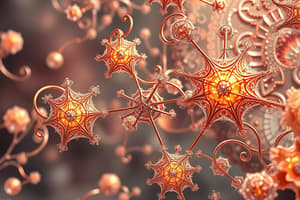Podcast
Questions and Answers
What is the maximum coordination number of Cu(II) that can be satisfied by ammonia?
What is the maximum coordination number of Cu(II) that can be satisfied by ammonia?
- 8
- 6
- 2
- 4 (correct)
What type of ligand can bind to a metal M with a coordination number of 4?
What type of ligand can bind to a metal M with a coordination number of 4?
- Either 4 unidentate ligands or 1 tetradentate ligand (correct)
- Only unidentate ligands
- Only tridentate ligands
- Only bidentate ligands
What is the equilibrium constant for the reaction M + L ⇋ ML?
What is the equilibrium constant for the reaction M + L ⇋ ML?
- K2
- K1 (correct)
- β2
- β1
What is the overall formation constant for the reaction M + 2L ⇋ ML2?
What is the overall formation constant for the reaction M + 2L ⇋ ML2?
What is the expression for the equilibrium constant K2?
What is the expression for the equilibrium constant K2?
What is the coordination number of a metal that can form complexes with a bidentate ligand glycine (gly) with formulas M(gly)+ and M(gly)2?
What is the coordination number of a metal that can form complexes with a bidentate ligand glycine (gly) with formulas M(gly)+ and M(gly)2?
What is the overall formation constant for the reaction M + nL ⇋ MLn?
What is the overall formation constant for the reaction M + nL ⇋ MLn?
What is the expression for the equilibrium constant β2?
What is the expression for the equilibrium constant β2?
What is the formation constant for the reaction M + L ⇋ ML2?
What is the formation constant for the reaction M + L ⇋ ML2?
What is the expression for the equilibrium constant β3?
What is the expression for the equilibrium constant β3?




